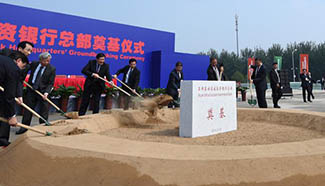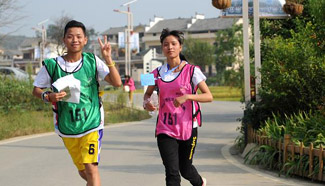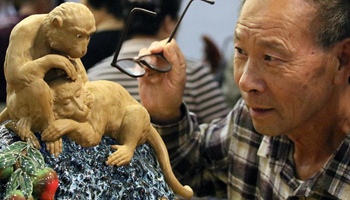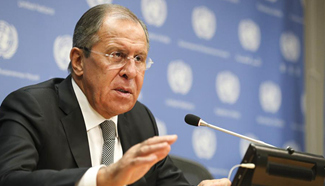Editor's note: The 2016 presidential race is seen by many as the most divisive and scandalous in the U.S. history. A team of Xinhua reporters recently toured several battleground states to get the firsthand accounts of what American voters really think before the Nov. 8 elections. Here is the third of a series of four in-depth reports they have produced.
YOUNGSTOWN, the United States, Sept. 23 (Xinhua) -- At the Golden Hunan Chinese restaurant in Youngstown, the U.S. state of Ohio, owner Yang Li was tied up serving her frequent customers and taking carryout orders at lunch hour.
Decades ago, she migrated to the United States from Tianjin, China in her teens with her family, but voting for president had never been on her table of priorities.
Her mother, watching her very much Americanized daughter swiftly striding through the tables and checking with customers, said she never felt the politicians' agendas were aiming to benefit the hard-working Asian Americans.
"Who has time to vote," her mother told Xinhua. "Look how busy she already is!"
INVISIBLE VOTING BLOC
"Neither the Democratic Party's platform nor the Republican Party's was representative of Chinese-Americans' interests," said Yumin Yin, who came to the U.S. in 1994 for graduate school and now works as a structural engineer in a construction design company in Columbus, Ohio.
With the Nov. 8 election less than two months away, Yin, who called himself an independent, said he has not yet decided who to vote for.
Education was the issue he cared about the most, said the father of two children.
Many Asian Americans share his view.
According to a survey by APIAVote, a non-profit organization dedicated to promoting political participation in the Asian American population, 48 percent of Asian American registered voters think education "extremely" important, the most among election related issues.
Some of the "affirmative action" legislation pushed by Democratic legislators effectively set up unfair barriers for Asian American children to access quality education, thus alienating some Asian American voters, Yin said.
Yin believed that many newly immigrated Chinese Americans are more economically well-off and tend to favor lower taxes and small government, which are more in line with the Republican platform.
But on other social issues like gun control and immigration, Chinese Americans would agree more with the Democrats, he said.
"That's why so many of us are on the fence," he said.
At a convenience store in downtown Charlotte, North Carolina, Mr. Kim was busy arranging stuff at his counter. He came here from South Korea when he was 15 years old and is now a U.S. citizen. But for over a dozen years, he hadn't cast a single vote in presidential elections.
"It will be the same, no matter who will be the president," he said.
The lack of passion about politics is quite common among Asian-American voters in the battleground states of Ohio and North Carolina.
Asian-American voters had long been left out in U.S. presidential elections.
In 2012, only 47 percent of Asian Americans voted in the presidential election, compared with 66 percent of black voters, 64 percent of non-Hispanic white voters, and 48 percent of Hispanic voters.
In the 2015 U.S. census, Asian Americans made up 4.9 percent of U.S. population, and are the fastest growing demographics in the U.S.
But a closer look at the policy proposals by both major party candidates found that very few are aimed to court Asian Americans.
Asian Americans are also much less likely to be contacted by political parties than other voters. According to the statistics by the National Asian American Survey in the 2012 election cycle, 69 percent of Asian American voters said that no one contacted them about the election.
Another survey done in 2014 showed that only one in three Asian American registered voters reported being contacted by Democrats, while an even smaller proportion of voters -- 24 percent -- reported being contacted by Republicans.
However, Asian Americans could be the tipping point for this election. If more people from this electorate cast their ballots, the result could be hugely swung, especially in battleground states.
In states like Nevada, Virginia and North Carolina, data showed the number of eligible Asian American voters exceeds the margin of victory in the 2012 presidential poll.
Yin recently went to a rally of Republican presidential nominee Donald Trump, attempting to ask him what was his plan to reach out to Asian Americans.
"I haven't been granted a chance to ask questions," he wrote in a posting on China's biggest messaging service Wechat.
THE UNDERREPRESENTED MINORITIES
The electorate will be more racially and ethnically diverse in the 2016 election cycle, according to Pew Research Center.
It is estimated that nearly one-in-three eligible voters on Election Day will be Hispanic, black, Asian or another racial or ethnic minority, up from 29 percent in 2012.
In recent decades, both Republicans and Democrats are racking more brains to win over African-Americans and Latinos which form the bulk of the minority population.
Polls showed Democratic presidential nominee Hillary Clinton with a wide advantage among black and Latino voters.
Trump, who has upset Mexicans and other minority groups with his tough stance on immigration, has also spent the past several weeks courting black Americans and asserting that President Barack Obama has failed the black community.
However, voter disenfranchisement in the system was also on the rise. On Election Day, people will not be allowed to vote in 10 states unless they have identification. Although touted as a prevention of voter fraud, many argued that it added substantial barriers to vote especially for the poor and minorities.
In many of the battleground states, stricter voter ID laws could definitely make a difference in the outcome, some voters feared.
In last election cycle, a study released in October 2012 by Brennan Center for Justice in New York University showed, as many as 11 percent of eligible voters did not have government-issued photo ID. People of color were among the group with greater possibility of not having one.
Even for eligible voters, enthusiasm for political participation is surely confronted by other factors, especially the depth of pockets.
The disparities in political participation are continuing to be significant between low-income and high-income persons.
According to the U.S. Census Bureau, less than half of Americans who earn less than 20,000 U.S. dollars a year voted in the 2012 election, while voter participation for people who live in households with incomes of more than 75,000 dollars was much higher at 77 percent.
African Americans and Hispanic Americans are much more likely to be poor than white Americans, the census showed.
During 2007 and 2011, poverty rate was 26 percent for African Americans and 23 percent for Hispanics, while less than 12 percent of white people were poor.
In Lowesville, North Carolina, Vanessa Blalock, an African American woman, was sitting in front of her dilapidated trailer home under the summer sun. Vanessa doesn't know much about either of the two candidates, as she hadn't been watching TV for some time due to lack of electricity.
Asked whether she would vote in this year's election, the mother of a daughter who is now living in New York, responded that in order to do that, she has to walk all the way to a bus stop, and take a bus. "It's difficult to travel," she stressed. (Reporting by Yuan Yue, Li Changxiang and Li Ming; Editing by Zhou Xiaozheng, Zhu Lei and Ding Yimin)











